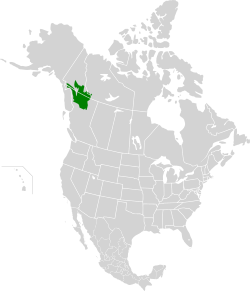Northern Cordillera forests
This article needs additional citations for verification. (April 2021) |
| Northern Cordillera forests | |
|---|---|
 Coniferous forest and deciduous shrubs along the Stewart–Cassiar Highway near Good Hope Lake | |
 | |
| Ecology | |
| Realm | Nearctic |
| Biome | Boreal forests/taiga |
| Borders | List
|
| Bird species | 165 [1] |
| Mammal species | 55 [1] |
| Geography | |
| Area | 262,884 km2 (101,500 sq mi) |
| Country | Canada |
| Provinces/territories | British Columbia, Northwest Territories, and Yukon |
| Climate type | Subarctic |
| Conservation | |
| Conservation status | Vulnerable |
| Habitat loss | 0%[1] |
| Protected | 11.6%[1] |
Northern Cordillera forests is a taiga ecoregion that extends across the northern interior of British Columbia, southern Yukon, and a small area of the Northwest Territories as defined by the World Wildlife Fund (WWF) categorization system.
Setting[edit]
This ecoregion occupies a transitional region of mountains, valleys, and high plateaus between the Coast and Saint Elias Mountains to the west, and the Northern Rocky Mountains to the east.
Climate[edit]
This ecoregion has a predominantly subarctic climate (Köppen Dfc ) with cool summers and cold winters. Mean annual precipitation is approximately 350-600 mm, but increases up to 1000 mm at higher elevations. The highest elevations feature an alpine tundra climate.
Ecology[edit]
Flora[edit]
The lower mountains and valleys are dominated by alpine fir, lodgepole pine, and black and white spruce all intermixed with a variety of deciduous shrubs. Higher elevations are dominated by dwarf birch, willow, and a variety of dwarf ericaceous shrubs. The highest elevations are dominated by grass, lichen, and moss.[2]
Fauna[edit]
Fauna found throughout this ecoregion include grizzly bear, black bear, moose, mountain goat, beaver, red fox, wolves, ptarmigan, and snowy owl.[2]
Conservation[edit]
Some protected areas of this ecoregion include:
- Denetiah Provincial Park and Protected Area
- Kusawa Territorial Park
- Nahanni National Park Reserve
- Neʼāhʼ Conservancy
- Spatsizi Plateau Wilderness Provincial Park
- Tā Chʼilā Provincial Park
See also[edit]
References[edit]
- ^ a b c d "The Atlas of Global Conservation". maps.tnc.org. Archived from the original on 2012-03-05. Retrieved 2020-10-28.
- ^ a b "Northern Cordillera forests | Ecoregions | WWF". World Wildlife Fund. Retrieved 2020-10-29.
External links[edit]
- "Northern Cordillera forests". Terrestrial Ecoregions. World Wildlife Fund.
